This post may contain affiliate links. Please see our disclosure policy.
Canning tomato juice is a simple, practical way to preserve the fresh flavor of summer tomatoes. Whether you grow your own or buy in bulk, turning them into smooth, seed-free juice is a great use for soft or overripe fruit. The finished jars are incredibly versatile—perfect for soups, sauces, or drinking straight. Best of all, this recipe can be safely canned using either a water bath or pressure canner.
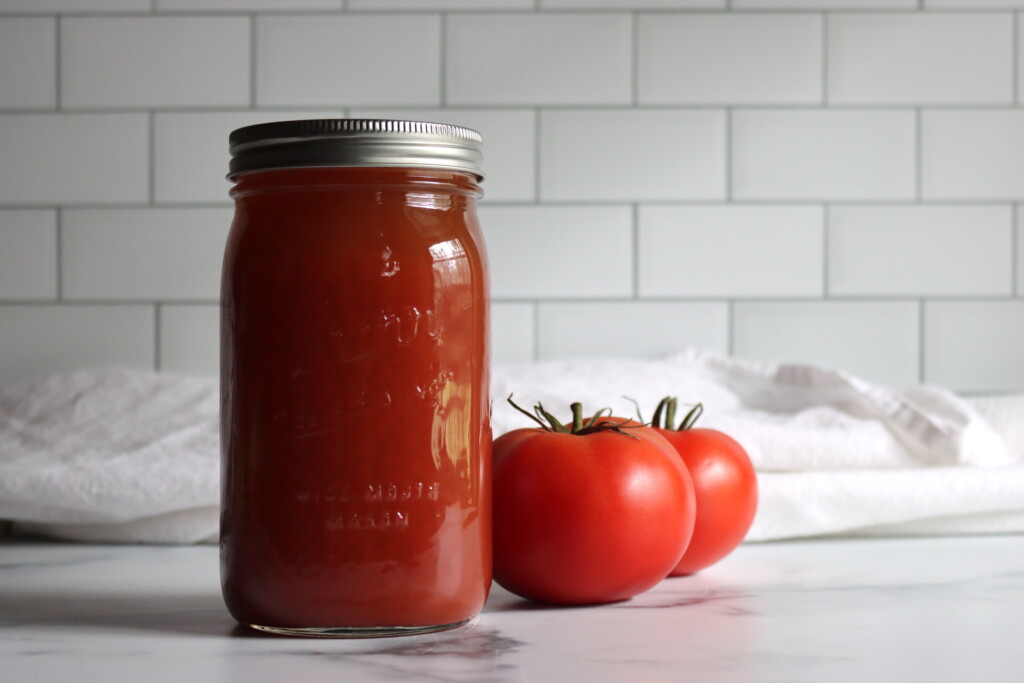
Every summer, once the tomatoes start rolling in faster than I can slice them for sandwiches or roast them for sauce, I break out the food mill and start canning tomato juice. It’s one of the easiest tomato preservation projects, and it’s incredibly versatile—perfect for soups, sauces, and even sipping if you like a good savory drink.
Tomato juice is also one of the rare canning recipes that gives you a choice between water bath canning and pressure canning. That flexibility means I can run a huge batch in my double decker amish water bath load while I’m prepping other tomato canning recipes in my outdoor canning kitchen, or I can knock out a batch quickly in the pressure canner when I’m short on time.
Either way, it’s shelf-stable and lasts all winter.
This particular method is a safe, tested recipe adapted from So Easy to Preserve by the University of Georgia Extension.
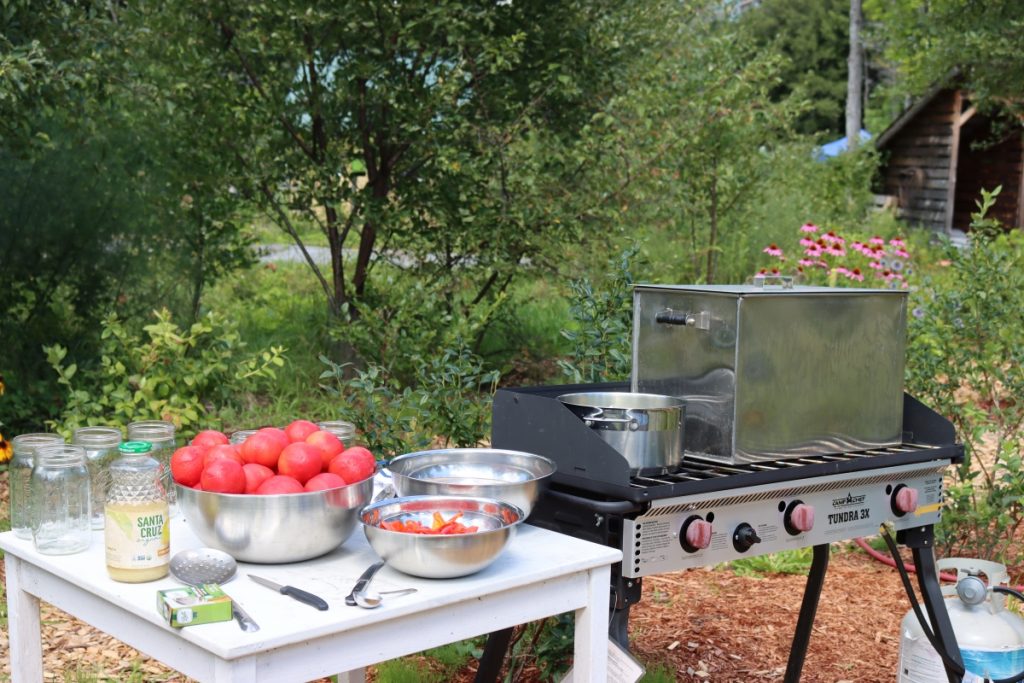
Ingredients & Yield
To make a full 7-quart canner load, you’ll need about 23 pounds of fresh tomatoes. For a 9-pint load, plan on 14 pounds. A bushel weighs around 53 pounds and yields 15 to 18 quarts of juice, depending on the variety and juiciness of your tomatoes. That’s about 3 ¼ pounds per finished quart on average.
You’ll also need:
- Bottled lemon juice or citric acid for acidification
- Salt (optional, for flavor only)
- A food mill or fine mesh sieve to remove skins and seeds
Canning Tomato Juice
Start by washing your tomatoes thoroughly, then remove the stems and trim off any bruises or blemishes. If you want to prevent juice separation—a common issue where the juice and pulp form layers in the jar—the key is to start heating and crushing a small batch of tomatoes immediately.
Cut about 1 pound of tomatoes into quarters and place them directly into a large saucepan. Heat to boiling while crushing with a spoon or potato masher. Keep the mixture boiling as you continue adding more quartered tomatoes a few pounds at a time, crushing and stirring constantly. Once all the tomatoes are in and bubbling, simmer the mixture for 5 minutes.
If you’re not concerned about separation, you can skip the staggered boiling and simply quarter all your tomatoes, crush them in the pot, and simmer everything for 5 minutes. That said, the separation is really unappetizing, and I’d strongly recommend getting the tomatoes heated as soon as they’re cut (more on that later).
Next, press the hot mixture through a food mill or sieve to remove skins and seeds.
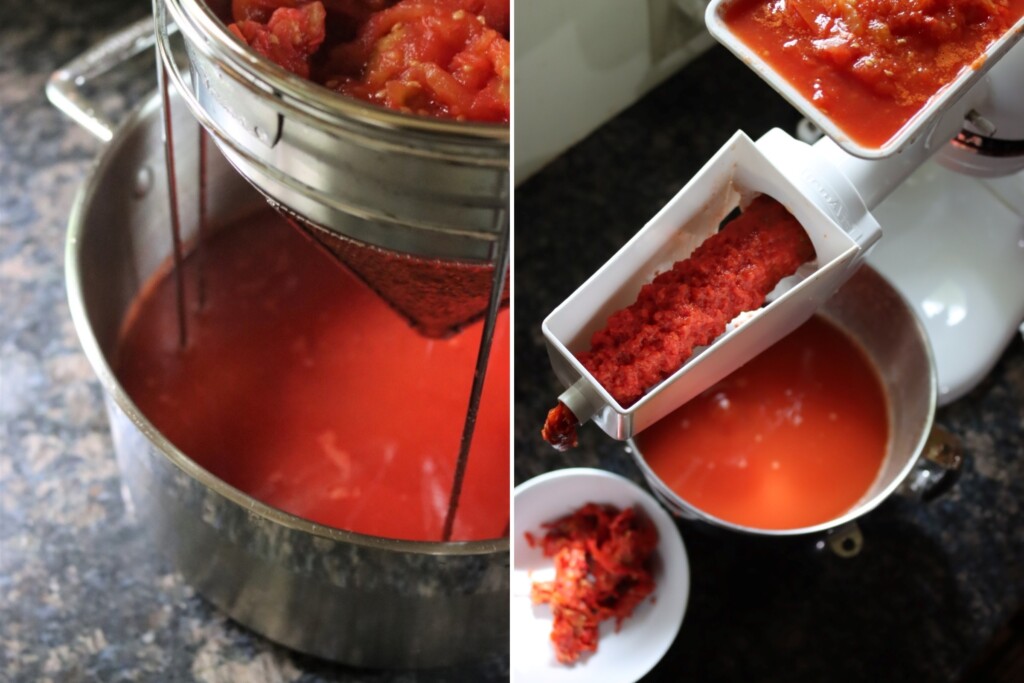
Return the juice to the pot and bring it back to a full boil.
While the juice heats, prepare your jars. Add bottled lemon juice (2 tablespoons per quart or 1 tablespoon per pint) or citric acid (½ teaspoon per quart or ¼ teaspoon per pint) to each jar to ensure safe acidity. Add up to 1 teaspoon of salt per quart if you like.
Pour the hot tomato juice into hot jars, leaving ½ inch headspace. Wipe the rims clean, apply lids and rings, and process using one of the approved methods below.
This particular recipe can be preserved in either a waterbath canner (with long canning times) or a pressure canner (with much shorter canning times). Either way, you must add lemon juice for safe canning, even when using a pressure canner.
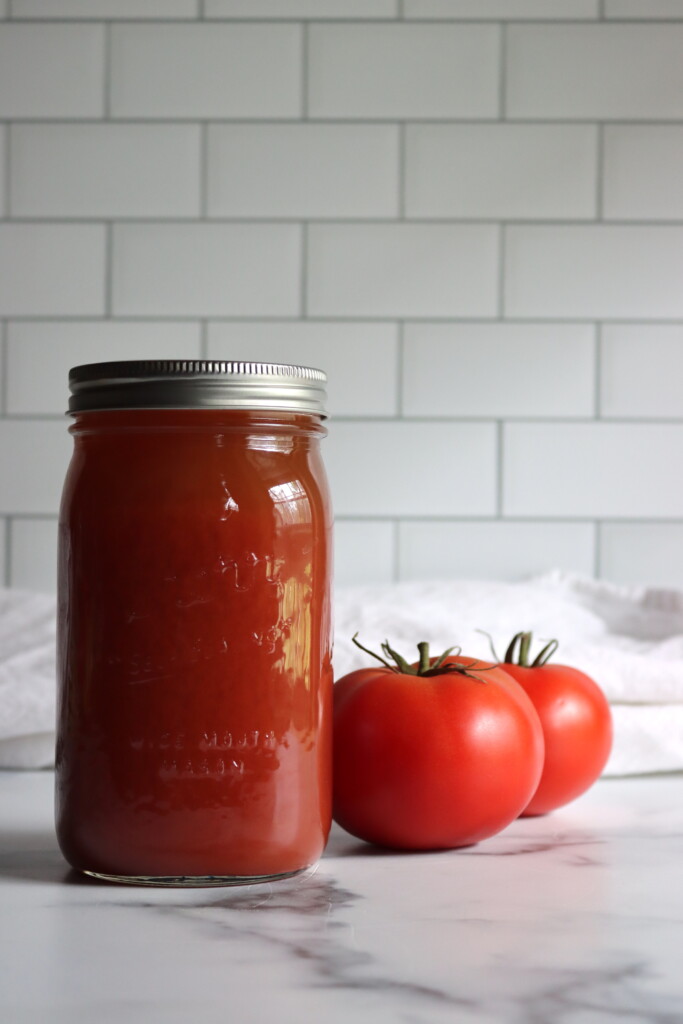
Water Bath Canning Times
Process jars of hot tomato juice in a boiling water bath canner. Be sure to adjust the time based on your elevation:
- 0–1,000 ft: 35 minutes for pints, 40 minutes for quarts
- 1,001–3,000 ft: 40 minutes for pints, 45 minutes for quarts
- 3,001–6,000 ft: 45 minutes for pints, 50 minutes for quarts
- Above 6,000 ft: 50 minutes for pints, 55 minutes for quarts
Pressure Canning Times
If you prefer to pressure can your tomato juice, process pints or quarts for 15 minutes, adjusting pressure based on your canner type and elevation.
Dial-Gauge Pressure Canner (15 minutes):
- 0–2,000 ft: 11 PSI
- 2,001–4,000 ft: 12 PSI
- 4,001–6,000 ft: 13 PSI
- 6,001–8,000 ft: 14 PSI
Weighted-Gauge Pressure Canner (15 minutes):
- 0–1,000 ft: 10 PSI
- Above 1,000 ft: 15 PSI
Acidification is required regardless of canning method. Don’t skip the lemon juice or citric acid.
Lemon Juice or Citric Acid
Even though tomatoes are naturally acidic, their pH can vary depending on the variety, ripeness, and growing conditions—especially with modern hybrids and heirlooms. To ensure every jar is safe for canning, especially when using a water bath canner, you need to acidify each one with bottled lemon juice or citric acid.
Bottled lemon juice is recommended because it has a standardized acidity (usually around 5%), unlike fresh lemons which can vary. For safe canning, add 2 tablespoons of bottled lemon juice per quart or 1 tablespoon per pint.
If you’d rather use citric acid, it works just as well and won’t alter the flavor. Use ½ teaspoon per quart or ¼ teaspoon per pint. Add the acidifier directly to the jar before filling it with hot juice.
This simple step doesn’t affect the taste of the final product, but it’s absolutely essential for safety—even if you’re pressure canning. While pressure canning reduces the risk of botulism, acidification ensures that your jars meet safe, tested guidelines and preserves the quality of the juice over time.
Why Cook the Tomatoes Immediately?
If you’ve ever opened a jar of home-canned tomato juice and noticed two distinct layers, clear juice on the bottom and thick pulp on top, you’ve seen juice separation in action. While it doesn’t affect safety or flavor, it can be a bit unappealing. The key to preventing this is how you cook the tomatoes at the start.
Tomatoes contain an enzyme called pectinase, which breaks down pectin, the natural substance that helps hold the pulp together. When you chop tomatoes and let them sit, that enzyme gets to work right away, causing the solids and liquids to separate during canning. By immediately heating the tomatoes as you chop and crush them, you deactivate the enzyme before it has a chance to break things down.
That’s why this tested recipe has you quarter a few tomatoes and bring them to a boil before adding the rest gradually, keeping everything at a rolling boil the whole time. This method locks the pulp and juice together for a smoother, more uniform product in the jar.
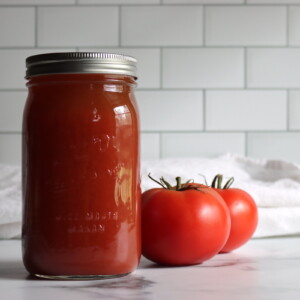
Canning Tomato Juice
Equipment
Ingredients
- 23 lbs tomatoes, fresh, whole, as purchased, for 7 quarts
- 14 Tbsp Bottled lemon juice, 1 Tbsp per pint, 2 Tbsp per quart
- 7 tsp Salt, optional, 1/2 tsp per pint, 1 tsp per quart, see notes for citric acid substitution
Instructions
- Wash tomatoes, remove stems, and trim any bruised spots. To prevent separation, start by quartering about 1 pound of tomatoes and placing them in a saucepan. Heat to boiling while crushing, then gradually add the remaining quartered tomatoes, keeping the mixture at a boil. Simmer for 5 minutes once all tomatoes are added.
- Press the hot mixture through a food mill or sieve to remove skins and seeds. Return juice to the pot and bring to a boil.
- Prepare jars and add acidifier to each jar: 2 Tbsp bottled lemon juice or ½ tsp citric acid per quart (1 Tbsp or ¼ tsp for pints). Add up to 1 tsp salt per quart if desired. Fill jars with hot juice, leaving ½ inch headspace. Wipe rims, apply lids and rings.
- Process jars in either a waterbath canner or pressure canner, using the instructions below (see notes). Be sure to adjust for altitude!
- Let jars cool undisturbed for 12–24 hours. Check seals, label, and store in a cool, dark place.
Notes
Water Bath Canning Times
Process jars of hot tomato juice in a boiling water bath canner. Be sure to adjust the time based on your elevation:- 0–1,000 ft: 35 minutes for pints, 40 minutes for quarts
- 1,001–3,000 ft: 40 minutes for pints, 45 minutes for quarts
- 3,001–6,000 ft: 45 minutes for pints, 50 minutes for quarts
- Above 6,000 ft: 50 minutes for pints, 55 minutes for quarts
Pressure Canning Instructions
If you prefer to pressure can your tomato juice, process pints or quarts for 15 minutes, adjusting pressure based on your canner type and elevation. Dial-Gauge Pressure Canner (15 minutes):- 0–2,000 ft: 11 PSI
- 2,001–4,000 ft: 12 PSI
- 4,001–6,000 ft: 13 PSI
- 6,001–8,000 ft: 14 PSI
- 0–1,000 ft: 10 PSI
- Above 1,000 ft: 15 PSI
Nutrition
Nutrition information is automatically calculated, so should only be used as an approximation.
Frequently Asked Questions
Yes, any type of tomato will work. Juicier varieties like beefsteak tomatoes will yield more juice per pound, while paste tomatoes like Roma tend to produce a thicker, more concentrated product.
Yes, this tested recipe is designed for juice that’s been pressed through a food mill or sieve to remove seeds and skins. Leaving them in would make it more of a sauce and could affect safe processing.
To prevent juice separation. Tomatoes contain an enzyme called pectinase, which breaks down the pulp and causes the juice to separate into layers. Heating the tomatoes right after cutting deactivates the enzyme and keeps the juice uniform and smooth.
Tomatoes don’t always have consistent acidity, especially with modern or heirloom varieties. Adding bottled lemon juice (2 Tbsp per quart) or citric acid (½ tsp per quart) ensures a safe pH for canning—even if you’re pressure canning. Bottled lemon juice is used instead of fresh because it has a reliably standardized acidity.
No, not for this recipe. Adding low-acid ingredients can affect the pH and make the recipe unsafe for canning. You can add seasonings later when you open the jar to use the juice.
Absolutely. Pour the finished juice into freezer-safe containers, leaving space for expansion, and store for up to 6 months. This is a good option if you don’t want to acidify your jars.
No, it’s just cosmetic. If your juice separates after canning, it’s still perfectly safe to use. Just give the jar a good shake before opening, or stir before using.
Tomato Canning Recipes
If you’re buried in tomatoes, I have plenty more tomato canning recipes for you to try!
For a rich, oven-roasted flavor, try the Roasted Marinara Sauce, which is water-bath safe and packed with concentrated tomato goodness. If salsa is more your style, the Tomato Salsa with Paste Tomatoes is a tested recipe that balances acidity with bold flavor—perfect for preserving alongside juice.
And when the weather cools down, you’ll be glad to have jars of Roasted Tomato Basil Soup ready to heat and serve straight from the pantry.

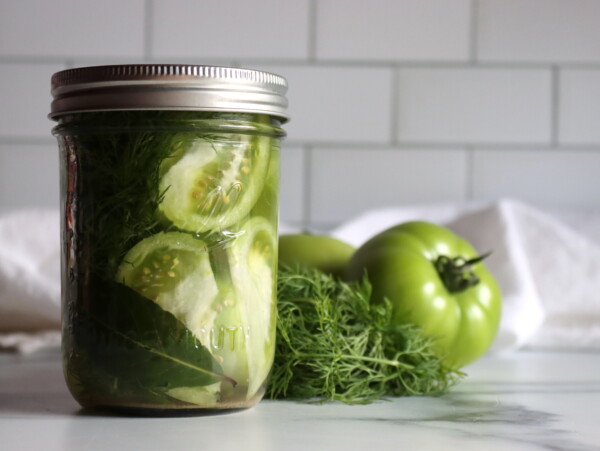

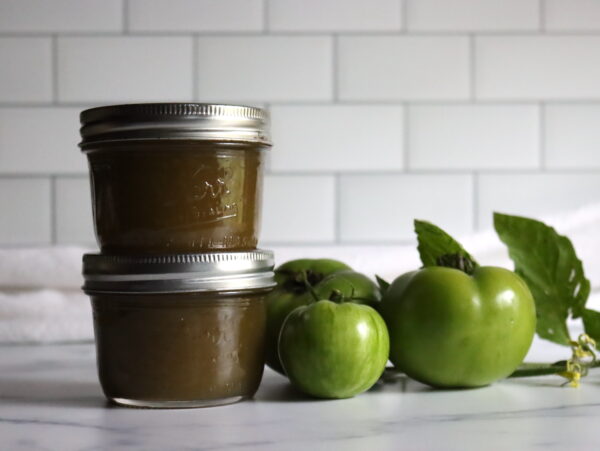

This one comes together so easily, and it’s the fastest way to put up tomatoes without a fuss!